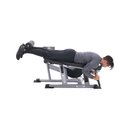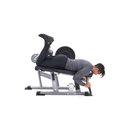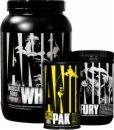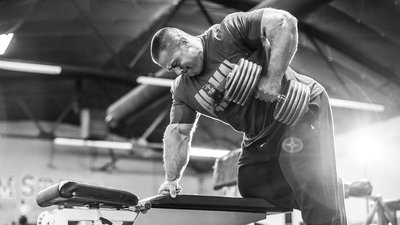All too often, I find that people look at training as something that's specific to a particular muscle group. To this way of thinking, each muscle group consists of separate muscles, each of which you have to train individually.
I used to think this way, too. But over the years, my philosophy toward training has become more systemic and holistic. I now understand that any time you lift, you engage your entire body, not just a single muscle. And any time you train intensely, you should feel the effects throughout your body.
You know what this feels like: You're out of breath, you're tired, you want to sit down, and you have an overall feeling of discomfort. Barbells and free weights create this feeling far, far more than machines. That feeling is one of the best tools you have at your disposal when you want to get in shape—any kind of shape— and it's the approach I used in both my training program Iron Intelligence and this back workout.
Perhaps one of the greatest opportunities to "do it correctly" and collect a big dividend is when you train your back. Done correctly, back training is very demanding. You can either go balls deep, or you can stop short of fulfilling your potential. It's your choice.
Everything You Need, Nothing You Don't
This is a basic but very effective workout for me. It includes barbell rows, T-bar rows, lat pull-downs, and dumbbell rows. Depending on what the rest of my training schedule looks like on a given week, I might add deadlifts to a workout like this as well.
On the day we made the video, I chose to keep the volume lower. Plus, the combination of barbell, dumbbell, and T-bar rows was pretty taxing, so I didn't feel like I needed to add anything else (I had just deadlifted two days prior on leg day).



BodyFit
$6.99/month- 2,500+ expert-created single workouts
- 3,500+ how-to exercise videos
- Detailed workout instruction
- Step-by-step workout tips
- Training at gym or at home
- Access to Workout Plans
- Access to Bodyfit App
- Store Discounts
Already have a Bodybuilding.com account with BodyFit? Sign In

What comes with BodyFit?

- Instructional Videos
Don't risk doing a workout improperly! Avoid injury and keep your form in check with in-depth instructional videos.

- How-to Images
View our enormous library of workout photos and see exactly how each exercise should be done before you give it a shot.

- Step-by-Step Instructions
Quickly read through our step-by-step directions to ensure you're doing each workout correctly the first time, every time.

Evan's Technique Keys
Hamstring curls: This may seem like an odd choice, but hear me out. Recently, I've been finding that a few sets of these before my back movements really help "switch on" my hamstrings so that I can feel them during heavy barbell rows or deadlifts, and actually preserve my lower back. I got the idea while doing deadlifts, which I sometimes like to superset with hamstring curls. I've found that when I do this particular superset, my lower back doesn't bother me from the deadlifts.
For both safety and performance, there should be more tension in your hamstrings than in your lower back during both of those movements. If that's been a problem for you, try this warm-up.
Barbell row: This is not an isolation movement. It's OK—even advisable—to use your legs to some degree. Why? If you try to keep your back 100 percent stiff, the stress you put on your lower back will increase as you go up in weight. Using your legs to "cushion" the negative portion of the rep will allow your legs, and not your lower back, to accept the brunt of the stress.

Barbell Row
That said, you should keep your back as parallel to the floor as possible. Aim for parallel, knowing you will likely end up around 45 degrees or slightly higher. If you round your back so much that your barbell rows start looking like modified shrugs, you'll lose everyone's respect as well as the intended training effect. Don't be that guy.
The effectiveness of this movement relies a good deal on the weight used. To handle that weight correctly, use good form. The heavier you go, the thicker your back will get. As long as your lower back is up to the task, starting with barbell rows will allow you to give the rows your greatest energy and power and move maximum poundage over maximum reps.
A welcome side effect of heavy barbell rows is increased strength in your lower back, hips, glutes, and hamstrings. If more than one muscle group can benefit from an exercise, that's a good thing.
T-bar row: Personally, I think that barbell rows are superior to T-bar rows; I would never replace the former with the latter. But I also think there's value in doing both of them in the same workout.
Why is doing both rows a good idea? Think about it: You start off with barbell rows and fatigue many of your back muscles. When you switch to the T-bar, you really finish things off while getting a slightly different feel from the movement. Plus, this row takes some pressure off your lower back.
It's important to note that even though the T-bar is hinged and operates as a lever, you should still use your legs to cushion the negative portion of the rep.
V-bar pull-down: This movement can be performed in a surprising number of ways. Most of the time, you'll see people sitting with their knees as far under the roller pads as possible and leaning back quite a bit as they lower the weight. Doing it this way makes it like a modified high row; it involves a lot more trapezius and rhomboid and a lot less lat.
Considering the beating my middle back (trapezius and rhomboids) has taken so far in this workout, my main reason for performing this movement is to hit my lats. This is the best movement I know of to really isolate them.

V-Bar Pull-down
To get the most out of this movement, sit with your knees just barely under the pads—enough so that you are stabilized, but no more than that. Keep the cable in front of you rather than overhead. Then, as you lower the cable to the top of your ribcage, keep your elbows in front of you rather than flared. Keep your chest high the whole time, and do not move your torso.
The only thing moving should be your arms. Don't forget to stretch at the top and squeeze at the bottom, doing all that you can to create tension in between. You're not trying to set records with weight or reps here, so focus on making each rep as difficult as possible.
Dumbbell rows: Over the years, I've tried several variations of this movement: with both feet on the ground and a hand on the rack, with one knee on a flat bench, and leaning into an incline bench. I've concluded that for me, the best way to perform the movement is with one knee on a flat bench.
This variation hits the sweet spot between "as easy as possible" and "as difficult as possible." By contrast, leaning into the incline bench puts you at such a disadvantage that you're unable to move any appreciable weight. Doing them right off the rack, on the other hand, allows you to use insanely large dumbbells that might stroke your ego but do very little for your back. I use 100-pound dumbbells with slow, controlled negatives to get the most out of this movement.
I also use a unique superset approach I included several times in Iron Intelligence. First, you rep to failure with one arm, then you immediately switch to the other arm and do the same. Then, without stopping, you switch back to the original arm and rep out again. If you got 10-12 reps the first time with each arm, you might only manage 5-7 the second time. Both of those segments together counts as one set. You'll do three.
Sets and Reps Are Just the Details
When it's all said and done, the main thing to remember is that an overall training "philosophy" or approach is more important than any particular routine. Sets, reps, exercises, and sequences can change at any time. But if you remember that your goal is to train, and you're ready to subject your body to as much discomfort as you possibly can, that's really all that matters.
If you approach training this way, the workout should practically structure itself. Believe me, you'll know when to stop. Your body will tell you, and you won't have to rely on some arbitrary end point.
Remember, the routines themselves are meaningless. Applying yourself, being committed to breaking barriers, and leaving comfort zones behind is what's important. Train hard, do it systematically, and enjoy the benefits.


